Chapter 2 semantic web
- 1. Chapter 2 XML & Its Impact
- 2. Introduction • Definition 2.1: XML is used to improve compatibility between the desperate systems of business partners by defining the meaning of data in business documents. • Definition 2.2: XML is a language allowing the exchange of structured data. Akerkar: Foundations of © Narosa Publishing House, 2009 2 Semantic Web.
- 3. The design goals for XML – XML shall be straightforwardly usable over the Internet. – XML shall support a wide variety of applications. – XML shall be compatible with SGML. – It shall be easy to write programs which process XML documents. – The number of optional features in XML is to be kept to the absolute minimum, ideally zero. – XML documents should be human-legible and reasonably clear. – The XML design should be prepared quickly. – The design of XML shall be formal and concise. – XML documents shall be easy to create. – Terseness in XML markup is of minimal importance. Akerkar: Foundations of © Narosa Publishing House, 2009 3 Semantic Web.
- 4. W3C Understanding XML • XML is for structuring data • XML looks a bit like HTML • XML is text, but isn’t meant to be read • XML is verbose by design • XML is a family of technologies • XML is new, but not that new • XML leads HTML to XHTML • XML is modular • XML is the basis for Resource Description Format (RDF) and the Semantic Web • XML is license-free, platform-independent and well- supported Akerkar: Foundations of © Narosa Publishing House, 2009 4 Semantic Web.
- 5. XML Processing • Example 2.1: gopal.xml is an XML document containing Gopal's resume. The document contains educational background, earlier work experience, references, and contact information by markup tags: <resume> <contact-info> ... </contact-info> <education> ... </education> <experience> ... </experience> <references> ... </references> </resume> Akerkar: Foundations of © Narosa Publishing House, 2009 5 Semantic Web.
- 6. XML Processing XML Processor gopal.xml gopal.html Akerkar: Foundations of © Narosa Publishing House, 2009 6 Semantic Web.
- 7. HTML & XML <p> The lecture notes on: <br /> <i> Semantic Web. </i> Author of the notes <br /> <b> R. Akerkar. </b> <book_title> Semantic Web </book_title> <author> R. Akerkar </author> <publisher> Narosa Publishing House </publisher> <copydate> 2008 </copydate> Akerkar: Foundations of © Narosa Publishing House, 2009 7 Semantic Web.
- 8. XML Prolog prolog ::= (declaration, misc*, dtd?, misc*) misc ::= (comment | pi) Here is a sample XML declaration: <?xml version = "1.0" encoding = "UTF-16" standalone = "yes"?> Akerkar: Foundations of © Narosa Publishing House, 2009 8 Semantic Web.
- 9. XML Comment – An XML comment has the same form as an HTML comment: <!-- this is an XML comment --> – XML processors ignore XML comments. – A processing instruction (PI) provides processing directions in the form of attribute values to a target XML processor. For example, the following PI tells a style sheet processor which style sheet should be used to process this document: <?xml:stylesheet type = "text/xsl" href = "outline.xsl"?> Akerkar: Foundations of © Narosa Publishing House, 2009 9 Semantic Web.
- 10. Elements element ::= (start-tag, content?, end-tag) | empty-elem-tag start-tag ::= <(name, attribute*)> end-tag ::= </name> empty-elem-tag ::= <(name, attribute+)/> content ::= (text | comment | pi | entity-ref | element)+ <memo> <from> Gopal <to> Gita </from> </to> Dinner tonight? </memo> Akerkar: Foundations of © Narosa Publishing House, 2009 10 Semantic Web.
- 11. Document Declaration • An XML document consists of a declaration followed by a single element called the root: <?xml version = "1.0"?> <ROOT> CONTENT </ROOT> Akerkar: Foundations of © Narosa Publishing House, 2009 11 Semantic Web.
- 12. XML Overview XML Concepts Elements & DTDs Namespaces Attributes Akerkar: Foundations of © Narosa Publishing House, 2009 12 Semantic Web.
- 13. Public Languages • A registry of public languages is maintained by xml.org at: http://www.xml.org/xml/registry.jsp W3C recommendations also include a number of public languages including XHTML, MathML, and SVG. Akerkar: Foundations of © Narosa Publishing House, 2009 13 Semantic Web.
- 14. Foreign Elements • A LabML report has the format: <experiment date = "..."> <introduction>...</introduction> <equipment-list>...</equipment-list> <procedure>...</procedure> <data>...</data> <analysis>...</analysis> <summary>...</summary> </experiment> Akerkar: Foundations of © Narosa Publishing House, 2009 14 Semantic Web.
- 15. XML Design Patterns • Document-Oriented <html> ... </html> <report> ... </report> <invoice> ... </invoice> <chapter> ... </chapter> • Data Oriented <employee> ... </employee> <measurement> ... </measurement> <organization> ... </organization> • Command Oriented <deposit> ... </deposit> <transfer> ... </transfer> <invoke> ... </invoke> <render> ... </render> Akerkar: Foundations of © Narosa Publishing House, 2009 15 Semantic Web.
- 16. Data Structures • Records • <record type = "student"> <field name = "name"> Gopal </field> <field name = "gpa"> 1.2 </field> <field name = "class"> B. Sc. Second Year </field> <!-- etc --> </record> • Or, less generically: • <student> <name> Gopal </name> <gpa> 1.2 </gpa> <class> B. Sc. Second Year </class> <!-- etc --> </student> Akerkar: Foundations of © Narosa Publishing House, 2009 16 Semantic Web.
- 17. Data Structures • Lists can be implicitly ordered by their position in the document (document order): <items> <item> 100 </item> <item> 200 </item> <item> 300 </item> <item> 400 </item> <item> 500 </item> </items> • Or the order can be made explicit: <items> <item id = "id4"> <data> 400 </data> <prev ref = "id3"/> <next ref = "id5"/> </item> …. …. Akerkar: Foundations of © Narosa Publishing House, 2009 17 Semantic Web.
- 18. • Example 2.2: Let us consider a document containing Rita Mathur’s address. This information can be represented as: <label> <name> Rita Mathur </name> <address> <street> 12 Jaiprakash nagar, Goregaon </street> <city> Mumbai </city> <state> Maharashtra </state> </address> </label> Akerkar: Foundations of © Narosa Publishing House, 2009 18 Semantic Web.
- 19. • Example 2.3: Attributes are used to represent the information. <address Street = “12 Jaiprakash nagar, Goregaon” City = “Mumbai” State = “Maharashtra” /> Akerkar: Foundations of © Narosa Publishing House, 2009 19 Semantic Web.
- 20. Namespaces • Namespaces are a simple mechanism for creating globally unique names for the elements and attributes of your markup language xmlns : prefix=”location” <xsd:integer> A sample namespace declaration: <xsd:schema xmlns:xsd=”http://www.w3.org/2001/XMLSchema”> Akerkar: Foundations of © Narosa Publishing House, 2009 20 Semantic Web.
- 21. Namespaces • A default namespace is declared by eliminating the prefix from the declaration: <html xmlns=”http://www.w3.org/1999/xhtml”> <head> <title> Default namespace </title> </head> <body> Web Programming </body> </html> Akerkar: Foundations of © Narosa Publishing House, 2009 21 Semantic Web.
- 22. Example 2.5 <?xml version="1.0" standalone="yes"?> ?> <DATARECORD> <PERSON> <FIRSTNAME>Ram</FIRSTNAME> <MEDDLENAME>Manohar</MIDDLENAME> <LASTNAME>Patel</LASTNAME> <CITY>Pune</CITY> <SALARY>Rs. 35000</SALARY> </PERSON> <PERSON> <PERSON> <FIRSTNAME>Jagan</FIRSTNAME> <FIRSTNAME>Raja</FIRSTNAME> <MEDDLENAME>Jeevan</MIDDLENAME> <MEDDLENAME>Ram</MIDDLENAME> <LASTNAME>Rai</LASTNAME> <LASTNAME>Venugopal</LASTNAME> <CITY>Mumbai</CITY> <CITY>Mumbai</CITY> <SALARY>Rs. 50000</SALARY> <SALARY>Rs. 80000</SALARY> </PERSON> </PERSON> <PERSON> <PERSON> <FIRSTNAME>Reema</FIRSTNAME> <FIRSTNAME>Pankaj</FIRSTNAME> <MEDDLENAME>Ravi</MIDDLENAME> <MEDDLENAME>Kumar</MIDDLENAME> <LASTNAME>Verma</LASTNAME> <LASTNAME>Sen</LASTNAME> <CITY>Delhi</CITY> <CITY>Pune</CITY> <SALARY>Rs. 65000</SALARY> <SALARY>Rs. 50000</SALARY> </PERSON> </PERSON> <DATARECORD> Akerkar: Foundations of © Narosa Publishing House, 2009 22 Semantic Web.
- 23. Document Type Definitions <!DOCTYPE name external-id? [internal-decs]?> Examples 2.6: Suppose we want to represent our books, records, CDs and DVDs in a library element. The following declaration requires that all books are listed before all records: <!ELEMENT library (book*, record*, cd*, dvd*)> By contrast, the following declaration allows us to list books, records, CDs, and DVDs in any order: <!ELEMENT library (book | record | cd | dvd)*> Akerkar: Foundations of © Narosa Publishing House, 2009 23 Semantic Web.
- 24. Attribute Types • There are three attribute types: attType ::= CDATA | token | enumerated – where CDATA is any quoted string. • There seven token types: token ::= ID | IDREF | IDREFS | ENTITY | ENTITIES | NMTOKEN | NMTOKENS Akerkar: Foundations of © Narosa Publishing House, 2009 24 Semantic Web.
- 25. Entity Declarations Example 2.8: <?xml version = "1.0" standalone = "no"?> <!DOCTYPE course SYSTEM "course.dtd" [<!ENTITY mt1 "midterm1"> <!ENTITY mt2 "midterm2"> ]> <course> <title> Web Programming </title> <semester> Fall 2008 </semester> <exams> <exam exam-id = "&mt1;" date = "2008-09-12" total = "100"/> <exam exam-id = "&mt2;" date = "2008-10-15" total = "100"/> <exam exam-id = "final" date = "2008-11-20" total = "200"/> </exams> <students> <student name = "Gopal Sharma" student-id = "A123" grade = Akerkar: Foundations of © Narosa Publishing House, 2009 25 Semantic Web.
- 26. Entity Declarations "A"> <score exam-ref = "&mt1;" total = "90"/> <score exam-ref = "&mt2;" total = "95"/> <score exam-ref = "final" total = "182"/> </student> <student name = "Rita Mathur" student-id = "A124" grade = "B"> <score exam-ref = "&mt1;" total = "90"/> <score exam-ref = "&mt2;" total = "78"/> <score exam-ref = "final" total = "155"/> </student> <student name = "Shila Soman" student-id = "A125" grade = "C"> <score exam-ref = "&mt1;" total = "70"/> <score exam-ref = "&mt2;" total = "70"/> <score exam-ref = "final" total = "140"/> </student> <!-- etc. --> </students> </course> Akerkar: Foundations of © Narosa Publishing House, 2009 26 Semantic Web.
- 27. XML Schema <?xml version = "1.0"?> <xsd:schema xmlns:xsd="http://www.w3.org/2001/XMLSchema"> <!-- global declarations go here --> </xsd:schema> <xsd:element name = "tag1" type = "Tag1Type"/> <xsd:element name = "tag2" type = "Tag2Type"/> <xsd:element name = "tag3" type = "Tag3Type"/> Akerkar: Foundations of © Narosa Publishing House, 2009 27 Semantic Web.
- 28. XML Schema xsd:string ::= <char>+ xsd:boolean ::= false | true xsd:decimal ::= (+ | -)?<digit>+(.<digit>*)? xsd:double ::= IEEE double precision float xsd:float ::= IEEE single precision float xsd:integer ::= (+|-)?<digit>+ xsd:duration ::= P<int>Y<int>M<int>DT<int>H<int>M<int>S xsd:time ::= <hours>:<mins>:<secs> <hours>, <mins> ::= <int>, <secs> ::= <decimal> xsd:date ::= <CCYY>-<MM>-<DD> xsd:anyURI ::= <URI> xsd:ID ::= <NCName> xsd:IDREF ::= <NCName> xsd:QName ::= <URI>:<NCName> xsd:Name ::= <XMLName> Akerkar: Foundations of © Narosa Publishing House, 2009 28 Semantic Web.
- 29. XML Schema <xsd:complexType name = "Tag1Type"> <!-- tag1 elements and attributes declared here --> </xsd:complexType> <xsd:complexType name = "Tag2Type"> <!-- tag2 elements and attributes declared here --> </xsd:complexType> <xsd:complexType name = "Tag3Type"> <!-- tag3 elements and attributes declared here --> </xsd:complexType> Akerkar: Foundations of © Narosa Publishing House, 2009 29 Semantic Web.
- 30. XML Schema • A default value (content) may also be specified: <xsd:element name = "tag" type = "TYPE" minOccurs = "N" maxOccurs = "M" default = "J"/> where: 0 <= N <= M <= "unbounded" Akerkar: Foundations of © Narosa Publishing House, 2009 30 Semantic Web.
- 31. Example 2.9 <review id="100"> <!-- movies.xml --> <movie-id>1</movie-id> <?xml version="1.0"?> <stars>5</stars> <!DOCTYPE movies SYSTEM "movies.dtd"> <comment>You can't call <movies> yourself a geek <movie id="1"> unless you've seen this <title>The Matrix</title> <b>amazing</b> </movie> movie.</comment> <movie id="2"> </review> <title>The Matrix: Reloaded</title> <review id="101"> </movie> <movie-id>1</movie-id> </movies> <stars>3</stars> <!-- movie-reviews.xml --> <comment><a href= <?xml version="1.0"?> <!DOCTYPE reviews SYSTEM "reviews.dtd"> "http://www.keanunet.com">Kean <reviews> u</a> can act!</comment> </review> </reviews> Akerkar: Foundations of © Narosa Publishing House, 2009 31 Semantic Web.
- 32. XPath Root Node Element Node Element Node Content Node Attribute Node Attribute Node Attribute Node Attribute Node Akerkar: Foundations of © Narosa Publishing House, 2009 32 Semantic Web.
- 33. Path Expression Consider the XML document library.xml: <library location =”Kolhapur”> <author name=”R. Akerkar”> <book title=”Artificial Intelligence”> <book title=”Building an Intelligent Web”> <book title=”Discrete Mathematics”> </author> <author name=”P. Winston”> <book title=”Artificial Intelligence”> </author> <author name=”V. Rajaraman”> <book title=”Information Technology”> <book title=”Supercomputing”> Akerkar: Foundations of © Narosa Publishing House, 2009 33 Semantic Web.
- 34. Path Expression V. author @name Rajaraman Information book @title Technology book Supercomp @title uting author @name P. Winston Artificial book @title Intelligence root library @name R. Akerkar Discrete author book @title Mathematics Building an book @title Intelligent Web Artificial book @title Intelligence @location Kolhapur Akerkar: Foundations of © Narosa Publishing House, 2009 34 Semantic Web.
- 35. Tree Representation Akerkar: Foundations of © Narosa Publishing House, 2009 35 Semantic Web.
- 36. Tree Representation Akerkar: Foundations of © Narosa Publishing House, 2009 36 Semantic Web.
- 37. XQuery • Example 2.10: This example searches the books.xml document and returns every chapter node's title child value. document("books.xml")//chapter/title • Example 2.11: Generates a new element <report> for each value for title. <report> {$b/title} </report> Akerkar: Foundations of © Narosa Publishing House, 2009 37 Semantic Web.
- 38. Example 2.12 • Perform a simple search that returns all books published by Narosa Publishers after 1998, inclusive of each book year and title. <bib> { for $b in doc("http://book.sample.org/bib.xml")/bib/book where $b/publisher = "Narosa Publishers" and $b/@year > 1998 return <book year="{$b/@year}"> {$b/title} </book> } </bib> Akerkar: Foundations of © Narosa Publishing House, 2009 38 Semantic Web.
- 39. Example 2.12 • The result follows: <bib> <book year="1999"> <title>Nonlinear Functional Analysis</title> </book> … … … <book year="2008"> <title>Foundations of Semantic Web</title> </book> </bib> Akerkar: Foundations of © Narosa Publishing House, 2009 39 Semantic Web.
- 40. Example 2.13 • Let us use the function min() to determine the minimum price for each book. – We generate the <minprice> element, with the book title as its attribute. <results> { let $doc := doc("prices.xml") for $t in distinct-values($doc//book/title) let $p := $doc//book[title = $t]/price return <minprice title="{$t}"> <price>{min($p)}</price> </minprice> } </results> Akerkar: Foundations of © Narosa Publishing House, 2009 40 Semantic Web.
- 41. Suggested Readings 1. R. Akerkar and P. Lingras. Building an Intelligent Web: Theory & Practice. Johns & Bartlett, 2008. 2. P. V. Biron, A. Malhotra (eds.): XML Schema Part 2: Datatypes, W3C Working Draft 07 April 2000, http://www.w3.org/TR/2000/WD-xmlschema- 2-20000407/. 3. T. Bray, J. Paoli, and C.M. Sperberg-McQueen (eds.): Extensible Markup Language (XML) 1.0, W3C Recommendation 10-February-1998, http://www.w3.org/TR/REC-xml. 4. T. Bray, D. Hollander, and A. Layman (eds.): Namespaces in XML, World Wide Web Consortium Recommendation, 14-January-1999, http://www.w3.org/TR/REC-xml-names/. 5. J. Clark (ed): XSL Transformations (XSLT), W3C Recommandation 16 November 1999, http://www.w3.org/TR/xslt. 6. J. Davidson: Java API for XML Parsing, Version 1.0 Final Release, http://java.sun.com/aboutJava/communityprocess/final/jsr005/index.html. 7. XQuery1.0: An XML Query Language, http://www.w3.org/TR/xquery/ 8. XML Query Use Cases, http://www.w3.org/TR/xmlquery-use-cases 9. What is XQuery: Katz, 2004. http://www.gnu.org/software/qexo/XQuery- Intro.html. Akerkar: Foundations of © Narosa Publishing House, 2009 41 Semantic Web.

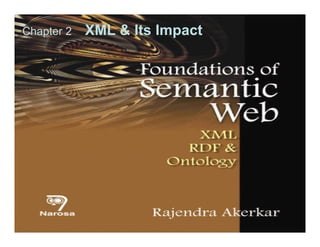


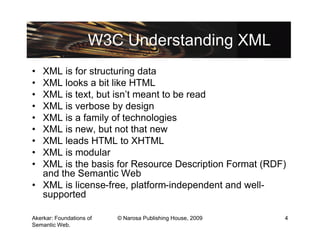
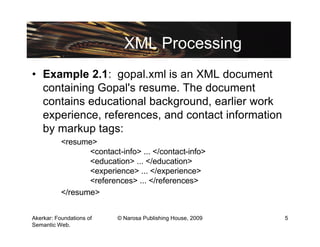







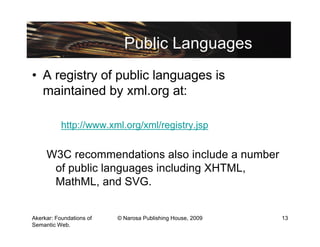









![Document Type Definitions
<!DOCTYPE name external-id? [internal-decs]?>
Examples 2.6: Suppose we want to represent our
books, records, CDs and DVDs in a library
element. The following declaration requires that
all books are listed before all records:
<!ELEMENT library (book*, record*, cd*, dvd*)>
By contrast, the following declaration allows us to list books,
records, CDs, and DVDs in any order:
<!ELEMENT library (book | record | cd | dvd)*>
Akerkar: Foundations of © Narosa Publishing House, 2009 23
Semantic Web.](https://image.slidesharecdn.com/chapter2semanticweb-110905082824-phpapp01/85/Chapter-2-semantic-web-23-320.jpg)

![Entity Declarations
Example 2.8:
<?xml version = "1.0" standalone = "no"?>
<!DOCTYPE course SYSTEM "course.dtd"
[<!ENTITY mt1 "midterm1">
<!ENTITY mt2 "midterm2">
]>
<course>
<title> Web Programming </title>
<semester> Fall 2008 </semester>
<exams>
<exam exam-id = "&mt1;" date = "2008-09-12" total = "100"/>
<exam exam-id = "&mt2;" date = "2008-10-15" total = "100"/>
<exam exam-id = "final" date = "2008-11-20" total = "200"/>
</exams>
<students>
<student name = "Gopal Sharma" student-id = "A123" grade =
Akerkar: Foundations of © Narosa Publishing House, 2009 25
Semantic Web.](https://image.slidesharecdn.com/chapter2semanticweb-110905082824-phpapp01/85/Chapter-2-semantic-web-25-320.jpg)
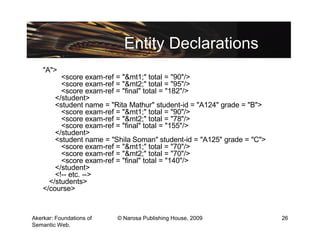













![Example 2.13
• Let us use the function min() to determine the
minimum price for each book.
– We generate the <minprice> element, with the book
title as its attribute.
<results>
{
let $doc := doc("prices.xml")
for $t in distinct-values($doc//book/title)
let $p := $doc//book[title = $t]/price
return
<minprice title="{$t}">
<price>{min($p)}</price>
</minprice>
}
</results>
Akerkar: Foundations of © Narosa Publishing House, 2009 40
Semantic Web.](https://image.slidesharecdn.com/chapter2semanticweb-110905082824-phpapp01/85/Chapter-2-semantic-web-40-320.jpg)
